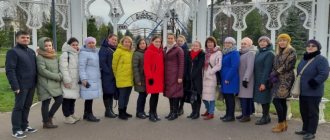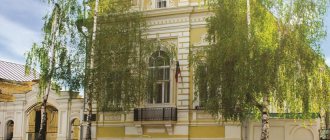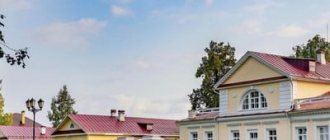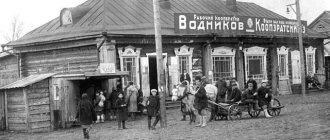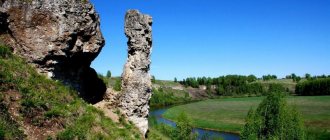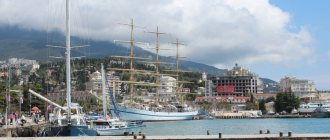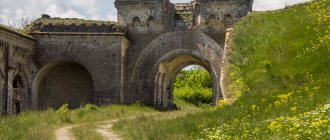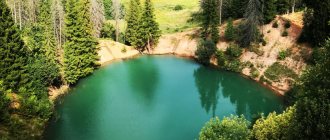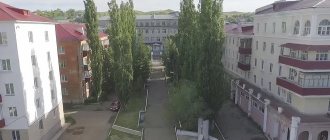Tourists often call Chistopol an “open-air museum.” Chistopol is located on the picturesque left bank of the Kama, about 140 kilometers from Kazana. In the former merchant city, historical buildings are still preserved, in which ancient mansions of wealthy citizens and Orthodox churches occupy an important place. One of them, the white stone Cathedral of St. Nicholas the Wonderworker, is rightfully considered the architectural dominant and symbol of the city.
The concept of “Clean Field”, which gave the city its name, was not born in these parts by chance. Archaeologists find settlements of ancient Bulgars here, and the village of Arkhangelskaya Sloboda, often called Clean Field, was mentioned in written sources already at the end of the 17th - beginning of the 18th century.
The village on the site of the future Chistopol was founded by serf peasants from among the fugitives who settled here en masse, then the schismatics exiled here joined them. They were going to organize a free settlement of co-religionists on the banks of the Kama. The first inhabitants called their new homeland Clean Field, since it was the empty fields and forests that first appeared before their eyes. At first, residents lived by hunting and fishing, but agriculture also quickly developed.
However, the lands here were state-owned, and the state was not going to put up with their unauthorized seizure, to which for the time being it turned a blind eye. The tsarist troops who arrived here destroyed and burned the settlement of the fugitives, leaving the same original “open field” in place of the village. New residents soon began to settle in - the sovereign's peasants sent here. The settlement was rebuilt again along with the former fugitives, who, for various reasons, survived the punitive expedition and avoided further exile. In the middle of the 18th century, a village already existed here again, even larger than before, and its inhabitants preferred to engage mainly in trade.
According to the census, by 1761 the number of residents of Chisty Pole exceeded a thousand people. Twenty years later, by decree of Empress Catherine II, the village was given the status of a district town of the Kazan governorate (since 1796 - a province). The newly created city began to be called Chistopol.
What to see first in Chistopol
Chistopol is a merchant city with a rich cultural heritage. It amazes with the variety of interesting objects to view. What attractions should you pay attention to first? What is worth visiting here in one day of stay?
City History Museum
- Address: st. Karl Marx, 8.
You can learn the history of the city and area, well-known and hidden pages of the daily life of merchants and cultural and historical figures in the local history museum. At the time of its opening in 1921, the Museum of the History of the City had this name. The initiator of its creation was the local scientist Alexander Bulich; the exhibition was based on specimens from his personal collection.
Today it is a large museum, which has more than 42 thousand storage units. The exhibition area exceeds 1100 square meters. m. As befits a museum of local history, its exhibitions cover a wide range of topics, telling about the nature of the region, stages of the history and development of the city, about the peoples who inhabited the Tatar lands in the vicinity of Chistopol.
The core of the exhibition is considered to be a section telling about the life of a county town in the 19th century and the life of a merchant. In some sources this museum is designated as the “Museum of the County Town”. The archaeological department, which reveals the secrets of antiquity, is also of great interest.
Since the late 1920s, the museum has settled in a historical building - the main mansion of the former estate of the eminent local merchant family Poduraev. The house in the Empire architectural style was built at the end of the 19th century on Bolshaya Ekaterininskaya Street. In Soviet times, the city artery received a new name in honor of the outstanding German philosopher and to this day remains Karl Marx Avenue.
St. Nicholas Cathedral
- Address: st. Karl Marx, 2.
Among the symbols and calling cards of the city is its main Orthodox church - the Cathedral of St. Nicholas the Wonderworker. The majestic structure, erected in the early 1830s, stands on the shore, proudly rising above the waters of the Kama River.
The five-domed white stone church, complemented on three sides by porticoes with a colonnade, has a formal and austere appearance. This is the creation of the famous master Pavel Pyatnitsky. The construction was sponsored by the wealthy Polyakov family. As a result, one of the most famous temple buildings in all of Tatarstan appeared to the world.
The cathedral building became the epicenter of the entire temple complex. There is a chapel and functional buildings around it. The ensemble is framed by a beautiful fence with an arched gate.
After almost a century of regular spiritual service, the temple was closed by the Soviet authorities in the 30s of the 20th century; the break in work lasted until 1990. During the “downtime” the building became worn out; in order to return it to its original solemn appearance, reconstruction was required.
Dzhuketau ancient settlement
- Coordinates on the map: 55.383642, 50.552571.
The most interesting archaeological site and pearl of ancient history are the remains of the ancient city of Volga Bulgaria, which can be seen not far from Chistopol, off the banks of the Kama. The tourist’s gaze will be attracted by the elevation – Linden Mountain, this is how the name of the ancient settlement – Dzhuketau – is translated from Tatar.
This city was part of the Golden Horde, and in the era of its greatest prosperity it was the center of the principality. The decline is associated with the invasion of Batu’s troops, who ravaged the settlement in the 13th century. The settlement occupies an area of 5.8 hectares, and is adjacent to two more settlements - Donaurovskoye and Krutogorskoye. Several necropolises have also been preserved here.
The scientific study of the object was carried out by a number of archaeologists, including A.I. Artemyev, T.A. Khlebnikova and others. As a result of research and excavations, it was possible to restore a picture of the daily life of the city, discover household items and handicrafts of local settlers.
Beautiful architecture and interesting museums of Chistopol
“City-museum” - this definition fully suits Chistopol. It is no coincidence that a historical, ethnographic and literary museum reserve was created here, which includes all the main city museums. The museum-reserve also organizes excursions around the city, because on the streets of Chistopol you can find many interesting “exhibits” - monuments of architecture and everyday culture.
Literary and Memorial Museum "Teacher's House"
- Address: st. Karl Marx, 28.
The word literary in the name of the museum is not accidental. The fates of famous writers are connected with the city. During the Great Patriotic War, Chistopol remained behind the front line and became a reliable rear for cultural figures.
The local branch of the Writers' Union was located here. The historical building on Karl Marx Avenue is also called the Teacher's House, since before the war teachers were trained here. The house became the center of cultural life: creative debates and performances by writers and poets took place here, receiving applause at a difficult time for the country. Today there is a literary museum here.
The interior has been preserved, keeping the memory of the stay of evacuated authors here: B. Pasternak, A. Fadeev, A. Tvardovsky, M. Isakovsky and many others. The exhibition presents interesting materials and memories of the turbulent life of the Teacher's House.
Memorial Museum of Boris Pasternak
- Address: st. Lenina, 81.
Townspeople and local historians remember the stay of Nobel laureate, poet and prose writer Boris Leonidovich Pasternak here. The writer was among those evacuated. He arrived in Chistopol in 1941.
The house where the writer lived has survived to this day, and in 1990 a memorial museum was opened there. At the beginning of the museum's history, the building, which remembered the outstanding author, remained inhabited. The exhibition was allocated only two rooms in which Boris Leonidovich lived. They recreate an authentic environment. Nowadays, the entire house belongs to the museum.
In addition to the permanent exhibition, which tells not only about the Chistopol period, but also about the life and work of the author in general, temporary exhibitions and various cultural events are held here.
Historical-Memorial and Ethnographic Museum of G. Iskhaki
- Address: Kutlushkino village, Klubnaya st., 10.
A local literary celebrity - Tatar writer Gayaz Iskhaki, a native of Chistopol district - is known for his creative and social activities. The novelist and publicist was an active participant in the national movement in Tatarstan.
In the writer’s native place, in the village of Kutlushkino, a museum has been operating in his honor since 1993. The house where the writer grew up has not been preserved, so the exhibition was first opened at the village cultural center, and later transferred to a merchant’s house belonging to the writer’s relative, a Tatar merchant. Ishaki stayed here when he came home on leave. The building is included in the cultural heritage list.
The museum tells not only about the life and work of this famous person, but also about the history and life of the Tatar village, about the everyday life of the original Tatar family, about the atmosphere in which the writer was formed.
The mansion of merchant Melnikov and the museum souvenir salon
- Address: Karl Marx street, 31.
A beautiful L-shaped corner building with an elegant bell-shaped “turret-dome” is an architectural monument of the 19th century, an object of cultural heritage of the Republic of Tatarstan. This is the main house of the estate complex of the wealthy merchant family of the Melnikovs, with outbuildings and outbuildings adjacent to it.
An example of an eclectic architectural style has incorporated elements of Art Nouveau; bay windows, massive cornices, platbands of large rectangular windows and other elements of rich but austere decor attract attention.
Inside the building there is one of the structural divisions of the museum-reserve - the museum souvenir salon, where works of decorative and applied art, handicrafts, works of artists, a variety of souvenirs, and printed publications are presented.
Chukashev estate and museum and exhibition complex
- Address: Karl Marx street, 15.
Another famous merchant estate in Chistopol also became one of the exhibition sites as part of the museum-reserve. The construction of the main house dates back to the first half of the 19th century, since the structure was recorded in the master plan of 1848.
The estate was built by the Chukashev merchant family at their own expense. The eclectic architectural appearance combines elements of classicism and baroque. The two-story residential building is richly decorated. The house has gone through a lot in its history, it was both the headquarters of the Red Army and an agricultural technical school, and hosted a factory workshop within its walls.
And starting from 2022, there are several interesting exhibitions dedicated to the history of the Soviet era: the Great Patriotic War, Soviet childhood. And one of the expositions is completely dedicated to Moscow.
Theological school building
- Address: Babel street, 121.
The history of the Chistopol Theological School began back in 1829. The educational institution acquired a three-story building on Bebel Street only towards the end of the 18th century; a new building was erected from 1891 to 1895.
The upper floors were occupied by the house church, consecrated in honor of St. Helena. Funds for construction were provided by the Chukashev merchant family. The eclectic appearance of the building, combining modern features with elements of stylization in the “pseudo-Russian” and “neo-Gothic” style, is the result of the work of the hereditary architect Lev Khrschonovitch.
The building is an outstanding example of civil architecture and is included in the list of cultural heritage sites of Tatarstan. During Soviet times, the building continued to perform an educational function; a branch of Kazan University settled here.
Estate of merchant Shashin
- Address: Narimanov street, 44.
A luxurious-looking historical building with large arched windows is the main house of the Chistopol estate, which was owned by the merchant Shashin. This is a monument to the eclectic architectural style, richly decorated in the Baroque spirit. Around the building there is a fence marking the courtyard area; the gates are made in the form of arches. There are outbuildings nearby.
The house where A.A. lived Akhmatova
A nondescript one-story corner building, built at the beginning of the 20th century, became a literary landmark. It would hardly have been included in the list of noteworthy places in the city if in 1941 its walls had not received the famous poetess Anna Andreevna Akhmatova. It was here that she created her famous work “Poem without a Hero.”
The house where the writer K. Fedin lived
“Test of Feelings” is a famous work by writer and playwright Konstantin Fedin. The play was born in Chistopol. The author was among those evacuated; Fedin spent two war years in a small wooden house located on Butlerov Street. In 1985, the board-clad building on a brick foundation acquired a memorial plaque commemorating the writer’s stay here. Unfortunately, it was recently demolished and a new building will be erected.
Estate of merchant Myasnikov
- Address: Lenin street, 34.
A remarkable elegant wooden building on Lenin Street serves as a meeting place for the hearts of loving Chistopol residents. It is given a ceremonial appearance by the presence of a portico with columns - not a common attribute for wooden structures. The registry office is located in a former merchant's house, rebuilt in the period 1870-1873. At the beginning of the 20th century, the owner of the land and the buildings located on it was the merchant E. Myasnikov.
Water tower
- Address: corner of Valieva and Pushkin streets.
The infrastructure facility of the early 20th century stands out for its unusual shape. The water tower in the city appeared thanks to merchant Ekaterina Chelysheva, who sponsored the construction. Currently he does not perform any functions. Notable as an object of everyday culture.
Migrations
Due to the fact that the region is economically well developed, it is attractive from the point of view of internal migration. So, one example of 2022 shows what an attractive place this part of Russia occupies for its residents.
During this calendar period, 4,419 people came here as internal migrants. But it is worth noting that there are also those leaving, 31,550 people. Some of them are internally displaced, while others. immigrate outside the country.
But, despite this, Tatarstan still remains quite attractive from the point of view of economic development.
Mosques and temples of the city of Chistopol
Tatarstan is a region where two religions coexist: Islam and Orthodoxy. The appearance of the city successfully combines ancient and modern churches for adherents of both faiths.
The first cathedral mosque "Nur"
- Address: st. Vakhitova, 39.
A wooden religious building in the traditions of national Tatar temple architecture of the 19th century. The mosque is the oldest in Chistopol and is one of the most ancient Islamic temples in all of Tatarstan. It was built in 1854 thanks to the investments of a merchant named Yakupov. The temple continues to regularly welcome adherents of the Islamic faith; throughout history, its activities have never stopped.
Iman Mosque
- Address: st. 40 years of Victory, 11.
The three-story temple, 6.5 meters high, was built in the 1990s and is considered the fourth largest mosque in the territory of the Republic of Tatarstan. Its total area is more than 1300 sq. m. An Islamic educational institution has been organized at the temple - a madrasah, where classes are held daily.
Church of the Kazan Icon of the Mother of God
- Address: st. Karl Marx, 67.
In the old cemetery of Chistopol, a monument of Orthodox culture has been preserved, an example of classicism in church architecture of the 19th century. The Kazan Church is the creation of the architect I.P. Bessonova, was built from 1840 to 1848. In the 1930s Soviet authorities closed the church, its premises were used as a prison. However, the break in spiritual service was short-lived; already in the war of 1943, the church again received parishioners.
Temple "Tenderness"
- Address: st. Lenina, 54K.
The newly-founded Orthodox church in Chistopol opened in 2013 on the occasion of the 1025th anniversary of the baptism of Rus'. It was decided to consecrate the temple in honor of the Tenderness icon. The brick religious building is remarkable for its interior decoration; the walls of the temple are decorated with picturesque paintings and frescoes with the lives of saints. They were created by artists from the Palekhovy Image workshop; a total of 18 specialists worked on the paintings.
Anas Mosque
- Address: st. Michurina, 10B.
With the revival of the religious culture of the peoples of Russia in recent decades, new Muslim churches began to appear in Chistopol. The Anas Mosque, built in 2009, looks very elegant. The initiator of the construction was a police officer, Colonel T. Akhmedzyanov.
The design of the building's façade combines green, orange and white colors. The Islamic temple is richly decorated. It has two separate entrances, for men and for women. Separate prayer halls are provided for parishioners of different genders in accordance with the traditions of the Muslim religion.
Chistopol gardens and parks where you can take a walk
In Chistopol there are several interesting squares and parks where citizens and tourists love to stroll in the evenings and more. As a rule, guests come here with children - attractions and entertainment are prepared for them.
Skaryatinsky Garden
- GPS coordinates: 55.364946, 50.647097.
The city's most famous park is not just a popular place for walking, but also an important historical landmark, one of the symbols of Chistopol, which has existed for more than a century and a half. The garden was laid out in 1867.
The garden received its name in honor of the statesman Nikolai Skaryatin. When he was governor, he gave local officials a thrashing for the presence of cluttered, unsettled territory in the city. This is where the garden appeared.
After the revolution, it was renamed the Karl Marx Park of Culture and Leisure, and a bust of the German philosopher appeared here. Then the garden was given back its historical name. In the 21st century, the park underwent reconstruction, its appearance was updated in accordance with the realities of the modern era.
Park-embankment KAMA
- Coordinates: 55.375772, 50.637691.
In 2015, a park was built along the banks of the Kama River, located on the embankment between the city beaches. At the entrance, visitors are greeted by elegant gazebos, next to which you can see an interesting art object - a clock that looks somewhat reminiscent of the legendary Big Ben.
The “Tree of Love” “grew” here, to which newlyweds traditionally come. Children coming here can have fun on the carousel, and adults can take a walk, enjoy the local scenery and swim. The surrounding beaches are equipped with everything necessary and meet safety requirements.
Mill Park
- Coordinates: 55.354973, 50.642183.
Near the 40th Anniversary of Victory Street you can see a park in the center of which there are three mills, one large and two smaller. This is a relatively new city attraction - the result of the initiative of local deputy V. Smykov. The Mill Park appeared in 2011.
National composition
Considering the national composition of the urban and rural population in a given district, it is worth highlighting the following prevailing nations:
- Tatars – more than 53%.
- Russians – 39%.
- Chuvash – more than 3%.
- Udmurts, Mordovians, Maris, Ukrainians, Bashkirs, Azerbaijanis and some other nationalities are less than 0.6%.
As can be seen from the above list, the main nationalities are Tatars and Russians. The remaining ethnic groups are represented by such insignificant groups that they do not influence the overall formation of the picture.
What monuments in Chistopol are worth visiting?
Chistopol monuments, monuments and memorials tell a lot of interesting things about the history of the city.
Monument to B. Pasternak
- Address: Skaryatinsky Garden.
Opposite the house of the B. Pasternak Memorial Museum, in the Skaryatinsky Garden, there is a monument to the writer. It was opened in 2015 on the occasion of the 125th anniversary of the author's birth. A three-meter bronze sculpture depicting young Boris Pasternak is the work of Moscow sculptors V. Demchenko and A. Golovachev.
Memorial complex "Alley of Heroes"
- Address: intersection of K. Marx and Babel.
In 1968, a monument dedicated to the Great Patriotic War was opened in Chistopol. In memory of the fallen soldiers, the Eternal Flame burns here. The central figure of the composition is a soldier; his sculpture was created by master I. Romanov. By 1975, a “Walk of Fame” appeared next to the monument, consisting of steles with the names of Chistopol heroes.
Thus, the final architectural appearance of the memorial complex in memory of the Great Patriotic War, which received the name “Alley of Heroes,” was formed. In addition to Ivan Romanov, sculptors Vladimir Skorokhodov, Pavel Samoilov and designer Ivan Chupaev took part in the creation of the complex.
Monument to the fighters for the establishment of Soviet power
- Address: intersection of Tolstoy and Marx streets.
The Monument to the Fighters for Soviet Power attracts attention with its composition. It was opened in 1957 on the site where the dead Bolsheviks were buried. The inscription on the pedestal: “Eternal glory to the fearless, faithful sons of the Motherland” is meaningful, does not give away “Soviet” content, and looks modern. The author of the monument is the famous Kazan sculptor I.A. Novoselov.
Climatic conditions
The climate of the city is moderately cold, continental, typical of the eastern part of the European Plain. The average annual temperature is about + 4 degrees, the annual precipitation is about 550 mm. The minimum amount of precipitation occurs in March (26 mm), the maximum in July (72 mm). The coldest month is January (-13°C), the warmest month is July (up to +20°C).
Climatic and soil conditions are favorable for the cultivation of many crops, with the exception of heat-loving ones.
Active recreation and entertainment in Chistopol
There are also places in Chistopol for active leisure and entertainment that you can visit in your free time after viewing cultural and historical attractions.
Cultural
- Address: st. Lenina, 17A.
Has been working in the city since 2010. The municipal cultural institution organizes recreation and leisure for the whole family: here you can visit a cinema or concert hall, play sports in a gym or fitness room, play bowling or billiards.
There are playrooms and slot machines for children. The center also offers services for holding celebrations and banquets. The institution is equipped with everything necessary for visiting it, including for people with disabilities.
Ice Sports Palace
- Address: st. Votyakova, 23.
Ice skating enthusiasts in Chistopol do not have to wait for winter - the Ice Sports Palace with artificial ice is open for them, where athletes train and public skating sessions are organized for everyone. It was opened in 2007 and now operates as a Children and Youth Sports School. In addition to the skating rink, there is a gym and a choreography department.
Dynamics
If we consider the dynamics of the population of the republic, here is how these figures have changed over the past almost 100 years:
- In 1926 – 2,594,032 people.
- In 1933 – 2,784,000 people.
- In 1959 – 2.850.000.
- In 1970 – 3.131.000.
- In 1987 – 3.568.000.
- In 1990 – 3.653.000.
- In 2000 – 3.789.688.
- In 2010 – 3.786.488.
- For 2022 This figure for the population reached 3,902,642 people.
- In 2022 there is a noticeable decrease – 3,894,507.
